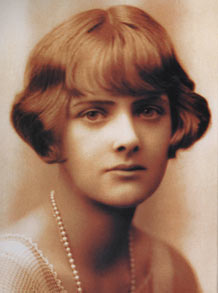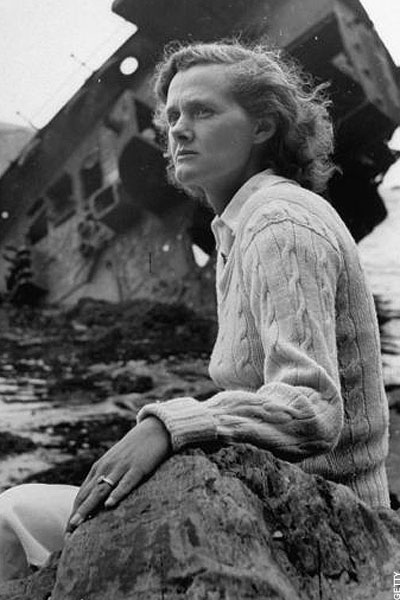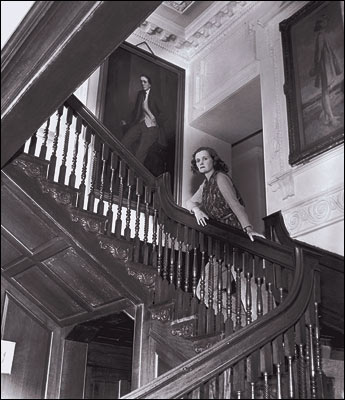<Back to Index>
- Physician Georgios Nicholas Papanikolaou, 1883
- Author Daphne du Maurier, 1907
- Politician, Engineer and Mathematician Lazare Nicolas Marguerite, Comte Carnot, 1753



Dame Daphne du Maurier, Lady Browning DBE (13 May 1907 – 19 April 1989) was an English author and playwright. Many of her works have been adapted into films, including the novels Rebecca, which won the Best Picture Oscar in 1941, Jamaica Inn, and her short stories The Birds and Don't Look Now. The first three were directed by Alfred Hitchcock. Her elder sister was Angela du Maurier, also a writer. Her father was the actor Gerald du Maurier, and her grandfather was the writer George du Maurier.
Daphne du Maurier was born in London (although she spent most of her life in her beloved Cornwall), the second of three daughters of the prominent actor-manager Sir Gerald du Maurier and actress Muriel Beaumont (maternal niece of William Comyns Beaumont). Her grandfather was the author and Punch cartoonist George du Maurier, who created the character of Svengali in the novel Trilby. These connections helped her in establishing her literary career; du Maurier published some of her very early work in Beaumont's Bystander magazine, and her first novel, The Loving Spirit, was published in 1931. Du Maurier was also the cousin of the Llewelyn Davies boys, who served as J.M. Barrie's inspiration for the characters in the play Peter Pan, or The Boy Who Wouldn't Grow Up. As a young child she was introduced to many of the brightest stars of the theatre thanks to the celebrity of her father; notably, on meeting Tallulah Bankhead she was quoted as saying that the actress was the most beautiful creature she had ever seen.
She married Lieutenant-General Sir Frederick "Boy" Browning and had two daughters and a son (Tessa, Flavia and Christian). Biographers have noted that the marriage was at times somewhat chilly and have also established that du Maurier could be aloof and distant to her children, especially the girls, when immersed in her writing. "Boy" died in 1965 and soon after Daphne moved to Kilmarth, near Par, which became the setting for The House on the Strand.
Du Maurier has often been painted as a frostily private recluse who rarely mixed in society or gave interviews. A notable exception to this came after the release of the film A Bridge Too Far in which her late husband was portrayed in a less-than-flattering light. Du Maurier was incensed and wrote to the national newspapers decrying what she considered unforgivable treatment. Once out of the glare of the public spotlight, however, many remembered her as a warm and immensely funny person who was a welcoming hostess to guests at Menabilly, the house she leased for many years (from the Rashleigh family) in Cornwall. Letters from Menabilly contains the letters from du Maurier to Malet over 30 years, with Malet's commentary. (Malet's real name is Auriel Malet Vaughan.)
Daphne du Maurier was a member of the Cornish nationalist pressure group/political party Mebyon Kernow. Du Maurier was spoofed by her slightly older fellow writer P. G. Wodehouse as "Daphne Dolores Morehead".
She died at the age of 81 at her home in Cornwall, the region which had been the setting for many of her books. Her body was cremated and her ashes were scattered at Kilmarth. After her death in 1989, numerous references were made to her secret bisexuality; an affair with Gertrude Lawrence, as well as her attraction for the wife of her American publisher, Ellen Doubleday, were cited. Du Maurier stated in her memoirs that her father, noted manager Gerald du Maurier,
had wanted a son and being a tomboy, she had naturally wished to have
been born a boy. Her father, unusual for such a prominent theatre
personality, was vociferously homophobic. There is some evidence to suggest that Daphne's relationship with her father may have bordered on incest. In correspondence released by her family for the first time to her biographer, Margaret Forster,
du Maurier explained to a trusted few her own unique slant on her
sexuality: her personality, she explained, comprised two distinct
people—the loving wife and mother (the side she shows to the world) and
the lover (a decidedly male energy) hidden to virtually everyone and
the power behind her artistic creativity. According to the biography du
Maurier believed the male energy was the demon which fueled her
creative life as a writer. One can best try to understand this if one looks to novels such as The Scapegoat or The House on the Strand, written in the first person and as male figures, as offering convincing evidence. Forster
maintains that it became evident in personal letters revealed after her
death, however, that du Maurier's denial of her bisexuality unveiled a
homophobic fear of her true nature.
In the Queen's Birthday Honours List for June 1969, Daphne du Maurier was created a Dame of the British Empire. She never used the title and according to her biographer Margaret Forster,
she told no one about the honour. Even her children learned of it from
the newspapers. "She thought of pleading illness for the investiture,
until her children insisted it would be a great day for the older
grandchildren. So she went through with it, though she slipped out
quietly afterwards to avoid the attention of the press". Literary critics have sometimes berated du Maurier's works for not being "intellectually heavyweight" like those of George Eliot or Iris Murdoch,
but to fully understand her importance in English literature one must
look first to the era in which she wrote. At the onset of her career,
with the horrors of the First World War still a fresh memory and the storm-clouds of the Second World War rumbling
on the horizon, her novels offered much-needed glamour, romanticism and
above all, escapism. But by the 1950s, when the socially and
politically critical "angry young men" were in vogue, her writing was
felt by some to belong to a bygone age of fiction. Today she has been
reappraised as a first-rate storyteller, a mistress of suspense: her
ability to recreate a sense of place is much admired, and her work
remains popular worldwide. For several decades she was the number one
author for library book borrowings. The novel Rebecca,
which has been adapted for stage and screen on several occasions, is
generally regarded as her masterpiece. One of her strongest influences
here was Jane Eyre by Charlotte Brontë. Her fascination with the Brontë family is also apparent in The Infernal World of Branwell Brontë,
her biography of the troubled elder brother to the Brontë girls.
The fact that their mother had been Cornish no doubt added to her
interest. Other notable works include The Scapegoat, The House on the Strand, and The King's General. The latter is set in the middle of the first and second English Civil Wars. Though written from the Royalist perspective
of her native Cornwall, it gives a fairly neutral view of this period
of history and is written with a great flair for that era. In addition to Rebecca, several of her other novels have been adapted for the screen, including Jamaica Inn, Frenchman's Creek, Hungry Hill and My Cousin Rachel (1951). The Hitchcock film The Birds (1963) is based on a treatment of one of her short stories, as is the film Don't Look Now (1973). Of the films, du Maurier often complained that the only ones she liked were Alfred Hitchcock's Rebecca and Nicolas Roeg's Don't Look Now. Hitchcock's treatment of Jamaica Inn involved a complete re-write of the ending in order to accommodate the ego of its star, Charles Laughton. Du Maurier also felt that Olivia de Havilland was totally wrong as the (anti-)heroine in My Cousin Rachel. Frenchman's Creek fared rather better with its lavish Technicolor sets and costumes, though du Maurier later regretted her choice of Alec Guinness as the lead in the film of The Scapegoat which she partly financed. Du Maurier was often categorised as a "romantic novelist" (a term she deplored), though most of her novels, with the notable exception of Frenchman's Creek, are quite different from the stereotypical format of a Georgette Heyer or Barbara Cartland novel.
Du Maurier's novels rarely have a happy ending, and her brand of
romanticism is often at odds with the sinister overtones and shadows of
the paranormal she so favoured. In this light, she has more in common
with the "sensation novels" of Wilkie Collins et al., which she admired. Du Maurier's novel Mary Anne (1954) is a fictionalised account of the real-life story of her great-great-grandmother, Mary Anne Clarkenée
Thompson (1776-1852). Mary Anne Clarke from 1803 to 1808 was mistress
of Frederick Augustus, the Duke of York and Albany (1763-1827). He was
the "Grand Old Duke of York" of the nursery rhyme, a son of King George
III and brother of the later King George IV. In Ken Follett's thriller The Key to Rebecca, du Maurier's novel Rebecca is used as the key for a code used by a German spy in World War II Cairo. Neville Chamberlain is reputed to have read Rebecca on the plane journey which led to Adolf Hitler signing the Munich Agreement. The central character of her last novel, Rule Britannia, is an aging and eccentric actress who was based on Gertrude Lawrence and Gladys Cooper (to whom it is dedicated). However, the character is most recognisably du Maurier herself. Indeed,
it was in her short stories that she was able to give free rein to the
harrowing and terrifying side of her imagination; "The Birds", Don't Look Now, The Apple Tree and The Blue Lenses are
exquisitely crafted tales of terror which shocked and surprised her
audience in equal measure. Perhaps more than at any other time, du
Maurier was anxious as to how her bold new writing style would be
received, not just with her readers (and to some extent her critics,
though by then she had grown wearily accustomed to their often
luke-warm reviews) but her immediate circle of family and friends. In later life she wrote non-fiction,
including several biographies which were well-received. This no doubt
came from a deep-rooted desire to be accepted as a serious writer,
comparing herself to her close literary neighbour, A. L. Rowse, the celebrated historian and essayist, who lived a few miles away from her house near Fowey. Also of interest are the "family" novels/biographies which du Maurier wrote of her own ancestry, of which Gerald, the biography of her father, was most lauded. Later she wrote The Glass-Blowers, which traces her French ancestry and gives a vivid depiction of the French Revolution. The du Mauriers is
a sequel of sorts, describing the somewhat problematic ways in which
the family moved from France to England in the 19th century and finally Mary Anne, a novel based on the life of a notable, and infamous, English ancestor—her great-grandmother Mary Anne Clarke, former mistress of Frederick, Duke of York. Her final novels reveal just how far her writing style had developed; The House on the Strand (1969)
combines elements of "mental time-travel", a tragic love-affair in 14th
century Cornwall, and the dangers of using mind-altering drugs. Her
final novel, Rule Britannia, written post-Vietnam,
plays with the resentment of English people in general and Cornish
people in particular at the increasing dominance of the USA. In late 2006 a previously unknown work titled And His Letters Grew Colder was
discovered. This was estimated to have been written in the late 1920s,
and takes the form of a series of letters tracing an adulterous
passionate affair from initial ardour to deflated acrimony. Daphne du Maurier wrote three plays. Her first was a successful adaptation of her novel Rebecca, which opened at the Queen's Theatre in London on 5 March 1940 in a production by George Devine, starring Celia Johnson and Owen Nares as the De Winters, and Margaret Rutherford as Mrs. Danvers. At the end of May, following a run of 181 performances, the production transferred to the Strand Theatre, with Jill Furse taking over as Mrs. De Winter and Mary Merrall as
Danvers, with a further run of 176 performances. In the summer of 1943
she began writing the autobiographically-inspired drama The Years Between about the unexpected return of a senior officer, thought killed in action, who finds that his wife has taken over his role as Member of Parliament as well as starting a romantic relationship with a local farmer. It was first staged at the Manchester Opera House in 1944, then transferred to London, opening at Wyndham's Theatre on 10 January 1945 starring Nora Swinburne and Clive Brook. The production, directed by Irene Hentschel became a long-running hit, completing 617 performances. After 60 years of neglect the play was revived by Caroline Smith at the Orange Tree Theatre in Richmond upon Thames on 5 September 2007, starring Karen Ascoe and Mark Tandy. Better known is her third play, September Tide, about a middle-aged woman whose bohemian artist son-in-law falls for her. The central character of Stella was originally based on Ellen Doubleday and
was merely what Ellen might have been in an English setting and in a
different set of circumstances. Again directed by Irene Hentschel, it
opened at the Aldwych Theatre on 15 December 1948 with Gertrude Lawrence as
Stella, enjoying a run of 267 performances before closing at the
beginning of August 1949. It was to lead to a close personal and social
relationship between Daphne and Gertrude. Since then September Tide has received occasional revivals, most recently at the Comedy Theatre in London in January 1994, starring film and stage actress Susannah York in the role originally created by Lawrence, with Michael Praed as the saturnine young artist.
Shortly after Rebecca was
published in Brazil, critic Álvaro Lins and other readers
pointed out many resemblances between du Maurier's book and the work of
Brazilian writer Carolina Nabuco. Nabuco's A sucessora (The Successor) has a main plot similar to Rebecca,
including a young woman marrying a widower and the strange presence of
the first wife — plot features also shared with the far older Jane Eyre. Nina Auerbach alleged, in her book Daphne du Maurier, Haunted Heiress,
that du Maurier read the Brazilian book when the first drafts were sent
to be published in England and based her famous bestseller on it.
According to Nabuco's autobiography, she refused to sign a contract
brought to her by a United Artists' worker in which she agreed that the
similarities between her book and the movie were mere coincidence. Du Maurier denied copying Nabuco's book, as did her publisher, claiming that the plot used in Rebecca was quite common.